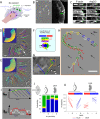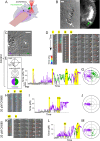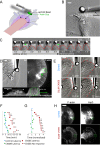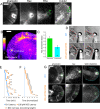Local Arp2/3-dependent actin assembly modulates applied traction force during apCAM adhesion site maturation
- PMID: 27852899
- PMCID: PMC5221634
- DOI: 10.1091/mbc.E16-04-0228
Local Arp2/3-dependent actin assembly modulates applied traction force during apCAM adhesion site maturation
Abstract
Homophilic binding of immunoglobulin superfamily molecules such as the Aplysia cell adhesion molecule (apCAM) leads to actin filament assembly near nascent adhesion sites. Such actin assembly can generate significant localized forces that have not been characterized in the larger context of axon growth and guidance. We used apCAM-coated bead substrates applied to the surface of neuronal growth cones to characterize the development of forces evoked by varying stiffness of mechanical restraint. Unrestrained bead propulsion matched or exceeded rates of retrograde network flow and was dependent on Arp2/3 complex activity. Analysis of growth cone forces applied to beads at low stiffness of restraint revealed switching between two states: frictional coupling to retrograde flow and Arp2/3-dependent propulsion. Stiff mechanical restraint led to formation of an extensive actin cup matching the geometric profile of the bead target and forward growth cone translocation; pharmacological inhibition of the Arp2/3 complex or Rac attenuated F-actin assembly near bead binding sites, decreased the efficacy of growth responses, and blocked accumulation of signaling molecules associated with nascent adhesions. These studies introduce a new model for regulation of traction force in which local actin assembly forces buffer nascent adhesion sites from the mechanical effects of retrograde flow.
© 2017 Buck et al. This article is distributed by The American Society for Cell Biology under license from the author(s). Two months after publication it is available to the public under an Attribution–Noncommercial–Share Alike 3.0 Unported Creative Commons License (http://creativecommons.org/licenses/by-nc-sa/3.0).
Figures





Similar articles
-
Substrate Deformation Predicts Neuronal Growth Cone Advance.Biophys J. 2015 Oct 6;109(7):1358-71. doi: 10.1016/j.bpj.2015.08.013. Biophys J. 2015. PMID: 26445437 Free PMC article.
-
The Ig superfamily cell adhesion molecule, apCAM, mediates growth cone steering by substrate-cytoskeletal coupling.J Cell Biol. 1998 Apr 6;141(1):227-40. doi: 10.1083/jcb.141.1.227. J Cell Biol. 1998. PMID: 9531561 Free PMC article.
-
The role of Arp2/3 in growth cone actin dynamics and guidance is substrate dependent.J Neurosci. 2014 Apr 23;34(17):5895-908. doi: 10.1523/JNEUROSCI.0672-14.2014. J Neurosci. 2014. PMID: 24760849 Free PMC article.
-
Actin dynamics in growth cone motility and navigation.J Neurochem. 2014 Apr;129(2):221-34. doi: 10.1111/jnc.12506. Epub 2013 Nov 17. J Neurochem. 2014. PMID: 24164353 Free PMC article. Review.
-
Grab your partner with both hands: cytoskeletal remodeling by Arp2/3 signaling.Sci Signal. 2009 Jan 27;2(55):pe5. doi: 10.1126/scisignal.255pe5. Sci Signal. 2009. PMID: 19176514 Free PMC article. Review.
Cited by
-
Growth cone macropinocytosis of neurotrophin receptor and neuritogenesis are regulated by neuron navigator 1.Mol Biol Cell. 2022 Jun 1;33(7):ar64. doi: 10.1091/mbc.E21-12-0623. Epub 2022 Mar 30. Mol Biol Cell. 2022. PMID: 35352947 Free PMC article.
-
The Arp2/3 complex is crucial for colonisation of the mouse skin by melanoblasts.Development. 2020 Nov 15;147(22):dev194555. doi: 10.1242/dev.194555. Development. 2020. PMID: 33028610 Free PMC article.
-
An Integrated Cytoskeletal Model of Neurite Outgrowth.Front Cell Neurosci. 2018 Nov 26;12:447. doi: 10.3389/fncel.2018.00447. eCollection 2018. Front Cell Neurosci. 2018. PMID: 30534055 Free PMC article. Review.
-
Actin-based growth cone motility and guidance.Mol Cell Neurosci. 2017 Oct;84:4-10. doi: 10.1016/j.mcn.2017.03.001. Epub 2017 Mar 6. Mol Cell Neurosci. 2017. PMID: 28268126 Free PMC article. Review.
References
Publication types
MeSH terms
Substances
Grants and funding
LinkOut - more resources
Full Text Sources
Other Literature Sources
Miscellaneous

